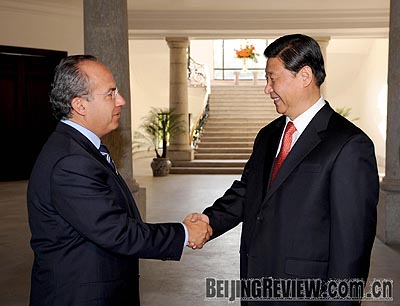|
Mexico has always been committed to free trade. President Calderón told Vice President Xi that Mexico is willing to cut its customs duties within the framework of the World Trade Organization. During the financial crisis, it is important to uphold free trade and oppose protectionism. At the G20 financial summit to be held in London in April, Mexico and China will carry out further negotiations on free trade.
The Chinese Government issued China's Policy Paper on Latin America and the Caribbean in November last year. In January this year, China joined the Inter-American Development Bank Group. What implications do you think these moves will have for upgrading relations between China and Mexico?
These moves showed China's interest in Latin America and willingness to cooperate with Latin American countries. President Hu visited Costa Rica, Cuba and Peru in November last year. Vice President Xi visited another five Latin American countries this February.
Latin American countries are also interested in cooperating with China. Mexico is open to Chinese investment. Since Mexico has free trade agreements with many countries, Chinese companies in Mexico can make use of these agreements to sell their products to other countries at low cost.
 |
|
FOSTERING FRIENDSHIP: Chinese Vice President Xi Jinping (right) meets Mexican President Felipe Calderón in Mexico City on February 10 (MA ZHANCHENG) | China's Relations With Latin America and the Caribbean
During the 20 years or so after the founding of New China in 1949, China and Latin America and the Caribbean mainly conducted people-to-people exchanges. In the 1970s and 1980s, China established diplomatic ties with most countries in the region. Friendly cooperation between the two sides in various fields registered momentous growth in the 1990s. Since the beginning of the 21st century, the two sides have enjoyed more frequent high-level exchanges, stronger political mutual trust and closer cooperation in economy, trade, science and technology, culture and education, and mutual support and close coordination in international affairs. New progress has been made in relations between the two sides in an all-round way at various levels and across a broad spectrum of areas.
Friendly cooperation between China and Latin America and the Caribbean serves the fundamental interests of the two peoples. Future growth of the relationship between the two sides enjoys great potential and broad prospects, and will contribute more significantly to peace and the development of mankind.
The goals of China's policy on Latin America and the Caribbean are:
--Promote mutual respect and mutual trust and expand common ground. Based on the Five Principles of Peaceful Coexistence, China and Latin America and the Caribbean will treat each other as equals and respect each other. They will strengthen dialogue and communication, enhance political mutual trust, expand strategic common ground, and continue to show understanding and support on issues involving each other's core interests and major concerns.
--Deepen cooperation and achieve win-win results. The two sides will leverage their respective strengths, tap the potential of cooperation, and seek to become each other's partner in economic cooperation and trade for mutual benefit and common development.
--Draw on each other's strengths to boost common progress and intensify exchanges. The two sides will carry out more cultural and people-to-people exchanges, learn from each other and jointly promote the development and progress of human civilization.
Source: China's Policy Paper on Latin America and the Caribbean
| 